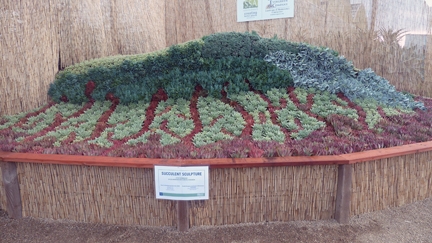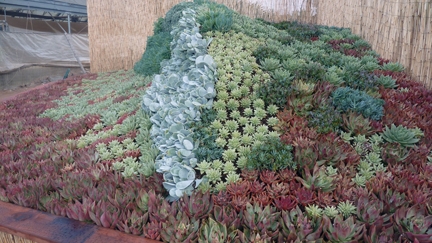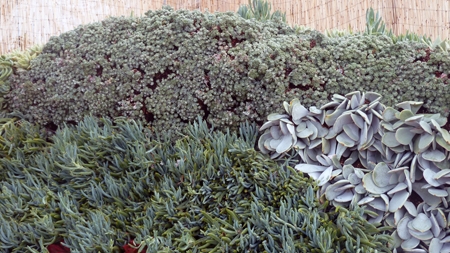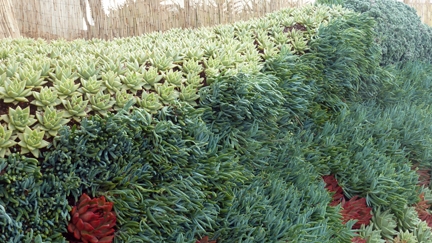Observations at Succulent Gardens Nursery, Part 2
The succulent wave sculpture at Succulent Gardens intrigued me immediately and held my attention. Not only were the textures, form and colors captivating, but being an ocean swimmer, I could easily relate to the feeling of this dynamic wave captured at its crest. This spectacular succulent garden was the other demonstration garden I monitored over the year, which debuted during Succulent Extravaganza at Succulent Gardens in Castroville in 2014.
By the greenhouses at the top of the property, the orientation of this garden gave it a strong east and south exposure. A retaining wall at the base of the planting set it about three feet off the ground, giving that much more force to the image. The top of the wave was then overhead, necessitating the need to look up at it. This was truly a sculptural piece to be taken in immediately upon impact with it.

Over 2400 individual plants were incorporated into the design but Steve used only six species to create a more powerful effect. The succulents he used included Senecio serpens, Senecio mandraliscae, Echeveria agavoides, Echeveria agavoides “Martin's Hybrid," Cotyledon orbiculata, and Sedum spathulifolium.


Sue Procter, another of the garden observers, previously took a class from Dr. Lorence R. Oki of UC Davis on sustainable landscaping. Dr. Oki, along with others at the UC Arboretum, developed a 5-point rating scale for evaluating a trial that they installed and monitored. Our group of volunteers all agreed that this 1-5 scale for evaluating the plants in our assigned landscapes would give us a good tool for documenting them over the course of the year.
This 5-point scale was applied to five characteristics of each plant or group of plants of the same species and can be summarized as such:
-Foliage:
5= Perfect to excellent, plants in full leaf with no leaf burn, disease or insect
4= Minor edge and/or tip burn, minor damage to only a few leaves.
3= Acceptable but not its best. Minor damage to all leaves which is less evident from a distance or severe damage to no more than 25% of plant.
2= Unacceptable. Moderate damage to most of the plant or major damage to more than 25%. Plant in decline and may not recover.
1= Unacceptable-close to dead.
-Flowering:
5= Height of bloom for the species.
4= 51% - 75% of plant in bloom.
3= 30% - 50% of plant in bloom.
2= 11% - 29% of plant in bloom.
1= One bloom or 10% of plant in bloom.
-Pest tolerance/Disease resistance:
5= No visible damage.
4= Minor damage only to a few leaves.
3= Minor damage to many of the leaves or flowers. Appearance still acceptable from a distance.
2= Major damage. Appearance unacceptable.
1= Severely damaged and probably dying.
-Vigor:
5= Pushing out a lot of new growth from every growing point.
4= Pushing out new growth from most growing points.
3= Plant is surviving and healthy but not pushing out much new growth, if any.
2= Plant very small for the species or unhealthy and declining.
1= Plant barely alive, close to death.
-Overall appearance:
5= Impressive plant. Leaves, flowers, shape and condition of plant very pleasing.
4= Very attractive plant. May rate a 5 when in bloom, or just a nice species that lacks the visual impact.
3= Acceptable but nothing special. May be past or not yet at its prime.
2= Unacceptable for any of the above reasons.
1= Unacceptable and probably not going to improve.
Working with this rating system over the course of the year really helped me to look at all plants in a different, positive way. It has given me a good reference point in which to evaluate the plants in my own yard and to focus on when I need to take action on any particular problems that arise.
As Master Gardeners we learn a lot in our training, yet each subject can be a life-long pursuit in learning more in-depth about that particular subject. Sometimes, for me, all the many different aspects of gardening can be a bit overwhelming. By implementing this rating scale for your own use it may help to clarify some of the garden issues you face and make the problem-solving job easier.
Evaluating the Wave Sculpture throughout the year I discovered a lot of consistency in this all-succulent display:
- Foliage consistently rated a 3-5.
- Flowering was seasonal with the most striking display in the spring with the Echeveria agavoides.
- Pests were minimal with the main issue being some aphids on flowers.
- Vigor was consistent despite the challenges of the planting, but also to consider was the dormancy period of the different species.
- Overall the plants performed well and did not outgrow their space.
The main problem encountered with this sculptural piece was that of gravity. With the weight of the plants and soil (especially when wet) a crevasse developed through the Senecio mandraliscae, causing some of the Echeveria agavoides planted on the top to dislodge. Erosion of the sandy soil during winter rains also partially buried some of the Echeverias at the base. Despite these problems though, this garden remained a spectacular piece and an excellent showcase for how succulents can be planted into a sculptural piece for your garden.